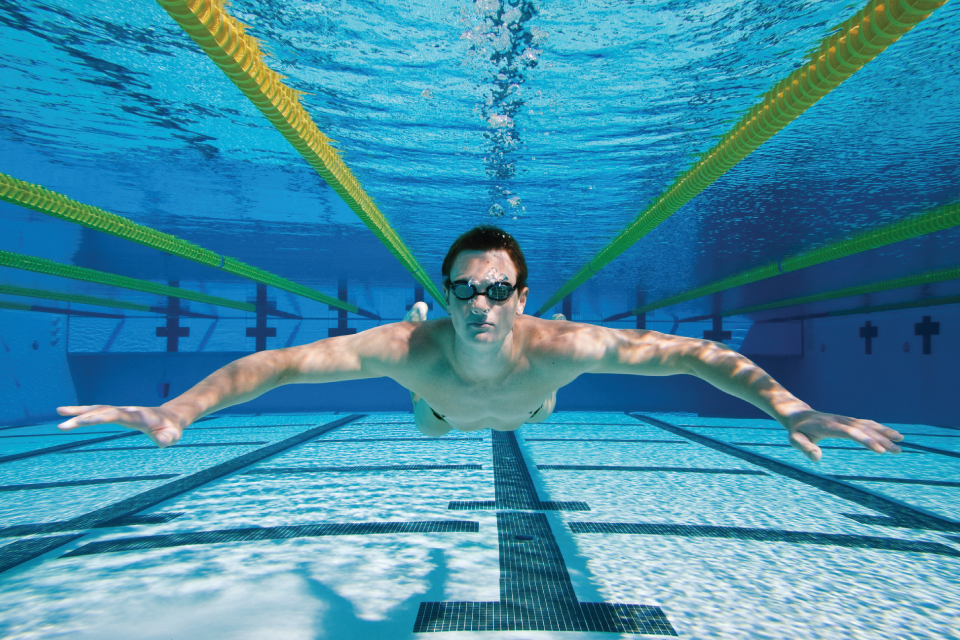More Play, Less Mileage

Triathletes, or folks who want to do a triathlon for the first time, are typically pretty fit, right? So some of them wonder why they feel more comfortable finishing a half marathon than swimming that first 25 yards when they dive in a pool. People who take up triathlons are generally “land animals” (runners or cyclists). Often when they get in the pool, they just want to get to the other side as fast as they can. What these folks need to understand is that they have to learn to swim at a jog or walk, not a run. You wouldn’t start out a training run by sprinting, and it is the same with swimming. To have a great swim workout, you need to be able to warm up, so being able to swim slowly and comfortably is actually an important skill.
Feel more comfortable and relaxed in the water by taking it easy when you first get in. Bob up and down before you start swimming, taking deep breaths and relaxing as you let them out underwater. It may sound remedial, but pushing off in a streamline and floating a few times before you get started is a great way to calibrate your body to its new environment. You want to feel level with the surface when you swim, so floating while you press on your chest and lungs (where you hold all your buoyancy) and feeling your hips rise to the surface sets you up to swim in the right position. In all likelihood, when you push off to float the first time, your eyes will be looking where you are going. Try it again with your eyes looking directly at the bottom of the pool, your neck relaxed, and see how much better your body position feels. This is where your head should be when you swim. They mark the bottom of the pool with all those lines for a reason. The lines let you know where you are without needing to look forward, so skip that step!
You can improve your swimming simply by improving your feel for the water. The water doesn’t provide enough resistance for you to muscle your way through it; you have to learn to hold it first. Fast gains in speed can be achieved by focusing on efficiency, not strength. Working on efficiency and feel is more like “play” than “training.” When you relax and enjoy the water, you can feel it better. When you don’t have an interval to make or a mileage goal to hit, you can really focus on feel.
Try starting a workout with floating and sculling. Sculling is when you move your forearms and hands in unison in different positions to propel yourself forward. If you practice sculling with no kick—or, even more fun, with feet first—you can learn a lot about your body balance and how to hold your body in the water. When you move on to swimming in your workout, you will be more attuned to how the water feels against your body: where the drag is, what feels more streamlined, or ways you can tweak your hand position to hold more water. Sculling gives you a chance to feel and hold the water in new ways, increasing your body awareness in the pool. What you learn will transfer to improved freestyle technique.
Sculling 101
The area from the fingertips to elbow is your “paddle” when you swim. There should be minimum bend at your wrist, so that the “paddle” (or surface) is as one. The base sculling position is lying on the surface, facing up or down, just as you would stand on land—your neck in line with your spine, not tilted up or down. Break this body position briefly to breathe to the front or side, and then resume the same balanced position.
Sculling should be done with no kick so you can really feel how those “paddles” are grabbing and holding the water. You will work more on body balance when you don’t have propulsion out back.
Play with sweeping your hands in and out, from in line with your shoulders to out wide of your body (not making a breaststroke motion, just sweeping in and out).
Play with the depth of your fingertips and the width of your scull: fingertips close to the surface, to all the way down, to pointing them at the bottom; hands moving not more than two feet apart to moving as wide as they can.
Play with your direction. Try sculling on your back and your front; try sculling with your feet facing the direction you are going.
Have some fun!






